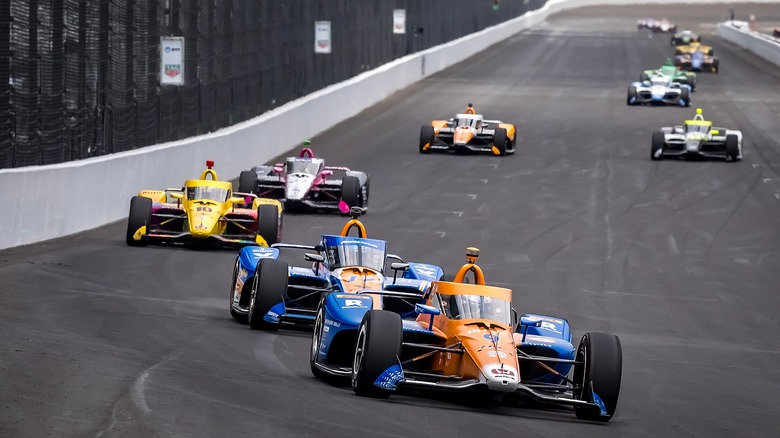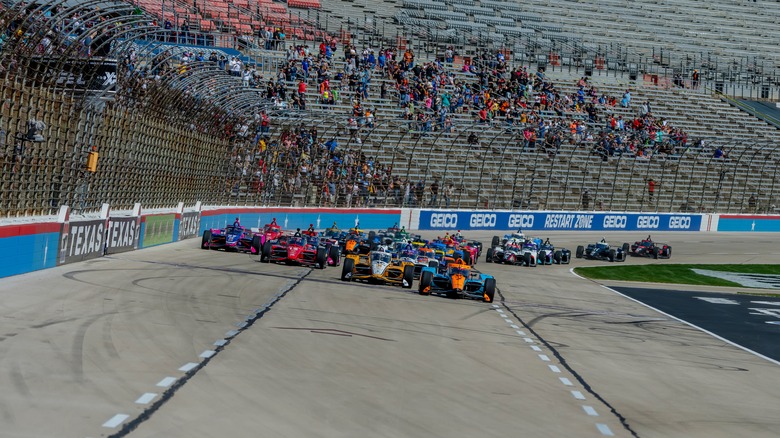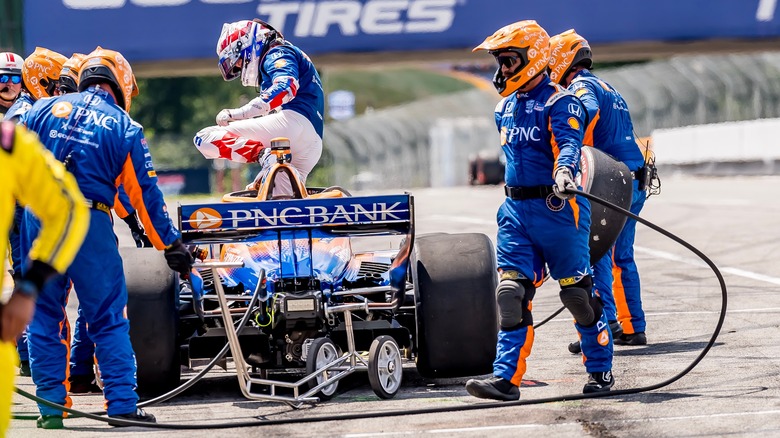What's The Difference Between Formula 1 And IndyCar Racing?
Auto racing is nearly as old as the automobile. Carl Benz's late-1880s Patent Motorwagen is generally regarded as the first car ever made, and speed and reliability contests were being held in France within a decade of its invention. The first organized race in the United States was an 87 kilometer round trip run from Chicago to the suburb of Evanston and back on Thanksgiving of 1895, and since those early days, the sport has become a global business consuming and generating billions of dollars each year.
There are countless levels and formats of auto racing, from weekend dirt track and vintage racing circuits to open-wheel championships that employ thousands of people and support entire cities for a weekend at a time. Open-wheel racing is just what it sounds like: competition in cars that have no fenders or other body structures covering the wheels and tires. The premier open-wheel racing series in the world are Formula 1 and IndyCar, but with the visual similarities between the cars used in those two series, casual fans might wonder if there are any significant differences between them. There certainly are, and we are here to highlight the most important ones for you.
F1 and IndyCar's locations and schedules are different
One of the main differences between Formula 1 and IndyCar, aside from the cars themselves, is the slate of races that are run to determine the champion of each series. While the 2024 Formula 1 calendar includes 24 races in 21 countries on five continents, IndyCar is running 18 races this year — 17 in the United States and one in Canada. The first IndyCar race was run on a 14.6 mile track in Portland, Oregon in June of 1909, and was a three-lap affair between six cars. The first Indianapolis 500, the race which the series eventually took its name from, wasn't held until almost two years later, in May of 1911.
The inaugural Formula 1 championship race was the 1950 British Grand Prix. Six more Formula 1 races were held that year: five across Europe and the Indy 500, which was a point-scoring race in F1 until 1960. Most F1 drivers and teams didn't cross the Atlantic to race at Indy in those years. That practice didn't become commonplace until 1961, when Jack Brabham logged a ninth-place finish at the Brickyard. Prize money talks, though, and more F1 teams started making the trip to Indianapolis in an attempt to snag some of the event's huge purse. Scotsman Jim Clark drove for the Lotus F1 team throughout most of the 1960s and had tremendous success at Indianapolis, placing second in 1963 and taking the checkered flag in 1965.
Formula 1 doesn't race on oval tracks like IndyCar does
Another big difference lies in the types of tracks that host Formula 1 and IndyCar races. Both series race on road courses — closed courses with both right and left turns like Circuit of the Americas outside Austin, Texas — and street circuits — adapted from and often using portions of regular roads in locations like Long Beach (IndyCar) and Monaco (Formula 1). The primary difference is IndyCar's use of oval tracks like Indianapolis and the Texas Motor Speedway in Fort Worth.
These oval tracks have banked turns that help keep cars stuck to the road surface. IndyCar has seven oval track events on its 2024 schedule: The Indy 500 first and then single races in Iowa, Nashville, and Madison, Illinois, plus a doubleheader in Milwaukee on the season's penultimate weekend. The closest thing Formula 1 has to an oval track is the outer circuit in Bahrain, a course it used for the second of two races held there during the pandemic-disrupted 2020 season.
Formula 1 has fewer entries than IndyCar
The Formula 1 grid had 12 teams of two cars each as recently as 2012, but has been frozen at ten teams since 2017. Each team fields two cars in each race, but can use up to four drivers over the course of a season. IndyCar had 11 teams with 27 full-time drivers last year, but is going to a charter system that includes ten teams and 25 entries starting in 2025. Those 25 cars will be guaranteed spots in every race but the Indy 500, which has a field of 33 cars. The F1 field may be growing soon, though. Andretti Global, an enterprise headed by former IndyCar and F1 driver Michael Andretti, got the green light from the FIA last Fall but was denied by Formula One Management, the commercial rights holder of F1.
Formula 1's complex administrative structure includes the FIA, which makes the rules, and hands out driver's and manufacturer's championships. However, Formula One Management holds the commercial rights and is owned by Colorado-based Liberty Media. The IndyCar series on the other hand is owned by Roger Penske through his company Penske Entertainment. Penske bought the series in 2020, along with the Indianapolis Motor Speedway.
The vehicles have different designs and engines
The ten F1 teams design and build their own cars, with different suspensions, bodywork and aerodynamics components. Four engine manufacturers supply engines for the ten F1 teams. Mercedes supports four teams, Ferrari three, Honda two, and Renault one. Audi and Ford will join the fray in 2026, when new engine regulations go into place. IndyCar teams all use chassis built by Dallara, and the engines are either Chevrolet or Honda-made powerplants developed in partnership with Ilmor Engineering. IndyCar and Formula 1 cars both use turbocharged V6 engines with hybrid systems, but the similarities end with those broad categorizations.
IndyCar engines displace 2.2 liters and have twin turbochargers. With the hybrid unit providing boost, they put out about 900 horsepower. F1 engines are smaller at 1.6 liters, but the 15,000 rpm redline allows them to crank out up to 1,000 horsepower. Despite that difference, Formula 1 cars top out at about 235 miles per hour, but IndyCars regularly top the 240 mark on the long straightaways at the Indianapolis Motor Speedway. F1 cars are designed to provide more downforce for cornering, and can handle up to 6g of lateral force compared to the roughly 4g felt by IndyCar drivers. IndyCar teams also all use the same aerodynamics package, which places the outcome of races in the hands of drivers instead of their engineers.
Formula 1 has far fewer American drivers
IndyCar had five different drivers sharing the past nine championships. It takes counting all the championships back to 2009 to count five unique F1 driver's champs, and Max Verstappen and Lewis Hamilton have had a stranglehold on that title for the last seven seasons. The 22 competitors who have run at least one Formula 1 race this season hail from 16 different nations, and only Logan Sargeant — who started 14 races for Williams before being sacked — was American. He was the only U.S. F1 driver since Alexander Rossi in 2015, and the first to score a point since Michael Andretti in 1993. The 43 drivers who have competed in IndyCar this season count 15 different nations as their homelands, but 15 are Americans, including Rossi. The other 2024 IndyCar drivers with F1 experience are Marcus Ericsson, Romain Grosjean, Takuma Sato, and Pietro Fittipaldi.
Phil Hill in 1961 and Mario Andretti in 1978 are the only two American champions in Formula 1 history, and no American driver has won an F1 race since Andretti took the checkered flag at the 1978 Dutch Grand Prix. Andretti was actually born in Italy, but came to the U.S. with his family at the age of 15. "Super Mario" was also the first driver to win both the Formula 1 and IndyCar Championships; Emerson Fittipaldi, Nigel Mansell, and Jaques Villeneuve have since matched that accomplishment.





